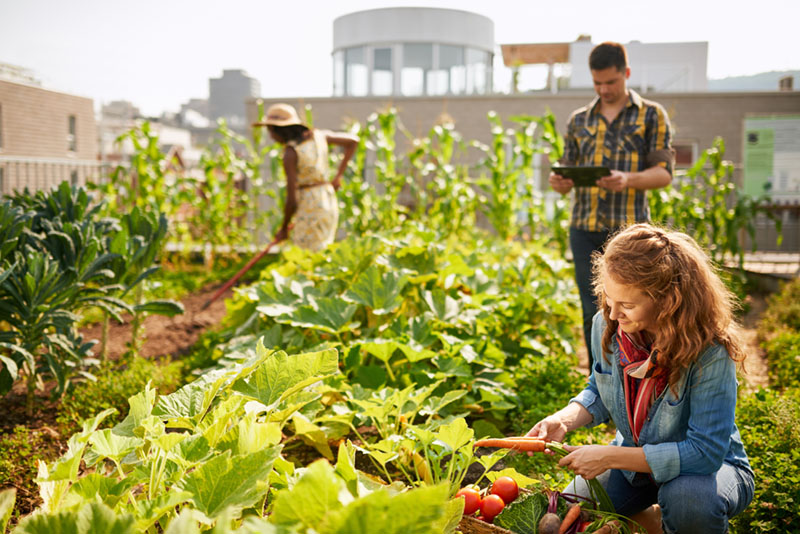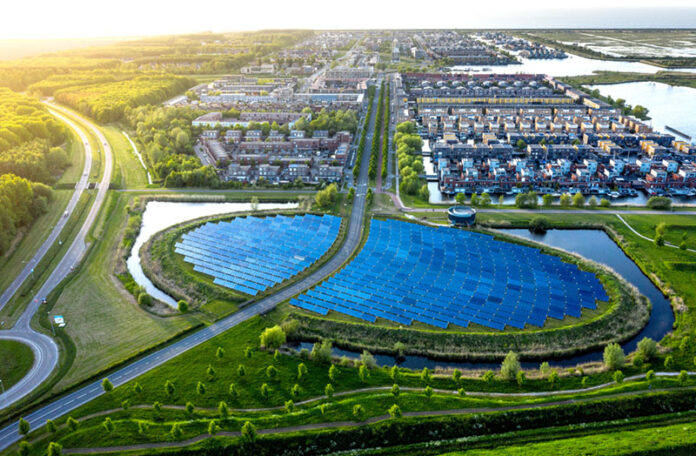Living sustainably can be a challenge—especially if we’re doing it on our own. That, along with growing levels of social disconnection and a planet that is increasingly depleted of its natural resources, has driven many people from around the globe to seek alternatives. One of these alternatives comes in the form of the sustainable communities that are now scattered around the world.
Let’s take a look at what sustainable communities are, and how they’re being implemented around the world.
Sustainable Communities, Defined
Depending on who you ask, the definition of a sustainable community might vary and depends on people, place, and other conditions. However, many researchers link the idea of a sustainable community to the definition of sustainable development that was produced in the Brundtland Report in 1987:
“Sustainable development is development that meets the needs of the present without compromising the ability of future generations to meet their own needs.”
This means that a sustainable community will embrace ideas of intergenerational equity, it will prioritize needs as opposed to wants, and it will consider those who have not yet been born in all decisions.
Reflecting some of the communes that popped up in the ‘60s and ‘70s, many modern sustainable communities, are committed to providing things like safe and healthy places for children, sustainable and shared shelter, conservation of resources, a sense of community, economic opportunities, and access to clean air and water are among the top considerations.


Additionally, most sustainable communities take into account diverse human needs and welcome people from all backgrounds and perspectives.
Some of the main issues that modern society faces—like income inequality, social injustice, and climate change—are also the top priorities for strong sustainable communities.
All of this sounds great, but it’s hard to fully grasp what a sustainable community is unless you can examine one directly. Fortunately, there’s no shortage of sustainable communities around the world, and there might actually be one closer to where you are than you think.
Examples of Sustainable Communities
Dancing Rabbit Ecovillage, Missouri
As arguably the most popular sustainable community in the United States, Dancing Rabbit Ecovillage has provided an example for others to follow for the past 20 years. It features organic and permaculture gardens, natural buildings, alternative energy, and a self-governance system.
In 1997, with a purchase of 280 acres, a group of neighbors decided to create a place where the environment was respected and people could join together in a community. To this day, any home that’s built at the ecovillage must adhere to sustainability guidelines with regard to materials, as well as the design itself.
Additionally, they work to foster a social structure that is both vibrant and non-exploitive, welcoming a diverse range of people who want to leave a positive mark on our planet. They have a cooperative car sharing program and power their homes using energy from the sun and wind.
Ecologically, the residents of Dancing Rabbit prioritize local and organic foods and have also preserved some of their land as wildlife habitat. In addition, they have also reintroduced native plants and have planted 10,000 trees to provide a sustainable source of wood for following generations.
Ecovillage at Loudoun County, Virginia
Amidst some of Virginia’s beautiful rolling hills lies the Ecovillage at Loudoun County. Surprisingly close to Washington DC—but still far enough away from the suburban sprawl—this sustainable community is home to more than 25 houses on 60 acres.
Homes must be built to meet minimum qualifications regarding green building practices, but each homeowner is able to choose the home and building that they prefer.
While the homes and lots are private, the community contains some common lands to practice sustainable stewardship. Additionally, there is a community garden, open fields, walking trails, a playground, and more. These areas not only foster human connection, but also serve as a certified monarch waystation and wildlife sanctuary.
Los Angeles Ecovillage, California
Surprised that there’s an eco-village amidst the hustle and bustle of Los Angeles? Yeah, we were, too. Just a few looks at the lush greenery of the Los Angeles Ecovillage Intentional Community, and you’ll be surprised that it’s in the middle of the Koreatown area of L.A.
Currently home to around 40 residents, the LAEV is committed to changing the way humans live by minimizing environmental impacts and raising the quality of community life. They started out in 1993 and now feature 50 units of housing under community control. Through collaboration with different nonprofit organizations, they’re able to provide affordable housing for households with low-to-moderate incomes.
The neighborhood features approximately 15 ethnic groups and of the 500 people living in the area around the ecovillage, 75% participate in LAEV activities.Some of these activities include community meetings, potluck dinners, workshops on permaculture, parties, and more.
Many community members do not own private cars, which gives them a discount on rent. Several members of the ecovillage have also started small businesses, made possible by some of the community buildings.
The Ecovillage at Currumbin, Australia
As an international award-winning sustainable community, The Ecovillage at Currumbin is a modern example of what living together and sustainably can look like. Located in Queensland, Australia, the 270-acre site is just seven minutes from the beach, and features 120 homes and 450 residents.
Started by a group of friends in the late 1990s, the ecovillage features homes that are 100% self-sufficient for water, in addition to other sustainability features. Edible landscaping helps to support local food production and extensive wildlife corridors support more than 180 bird species, along with many other native animals and plants.
It’s no surprise that the community has been awarded more than 33 accolades, given that it contains a cafe, a community hall, a large pizza oven, playgrounds, a greengrocer, and more. Oh yeah, it’s also home to 65 resident kangaroos!
Ecovillage at Ithaca, New York
Since 1991 the Ecovillage at Ithaca has been a part of the global community committed to finding and creating solutions to some of the economic, social, and environmental crises we currently face. The award-winning sustainable community is all about experiential learning when it comes to meeting needs for food, energy, shelter, livelihood, and social connection.
As a fully functional community, the Ecovillage at Ithaca features not only homes but also roads and paths, farms and gardens, and shared buildings and land. On around 175 acres, there are two 30-home cohousing neighborhoods along with one more 40-home cohousing neighborhood. Totaling 100 homes and 220 residents, this is the largest cohousing community on the planet!
Additionally, they also have an organic CSA vegetable farm, an organic berry farm, shared office spaces, a root cellar, and a 50-acre conservation easement—to list just some of what this sustainable community has to offer.
BedZED, England
Formerly known as the Beddington Zero Energy Development, BedZED was the first large-scale eco-village constructed in the UK. Completed in 2002, it features 100 homes, along with community facilities, a college, and office spaces.
Every aspect—from construction to current usage of space—was designed with sustainability in mind. More than half of the construction materials were sourced locally, 15% of which were reclaimed or recycled. Interestingly, the steel that supports the building was sourced from an old railway station!
Even the land that the eco village is on has been repurposed. It was a former sludge site for sewage works, but now has been transformed into an eco-conscious space for plants and people.
Sustainable home design means that the homes are highly insulated and heated by the sun. A biomass boiler is used to provide additional heat and, along with solar panels and energy-efficient appliances, the sustainable community has zero carbon requirements.
Even as a high-density development, there is an abundance of green space, including private outdoor areas, small gardens, and a large sports field. Perhaps because of some of these outdoor spaces, the eco village has fostered a great community and children and adults alike are typically found outdoors connecting with one another.
Final Thoughts on Sustainable Communities
Have you ever visited an eco-village or sustainable community? Would you want to live in one? We’d love to know your thoughts, so feel free to share any in the comments below!














